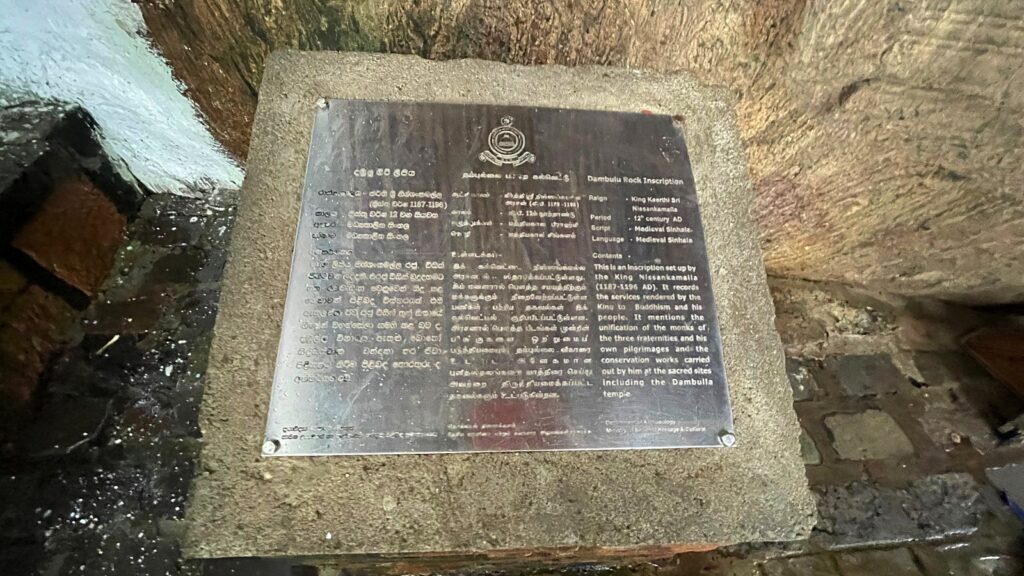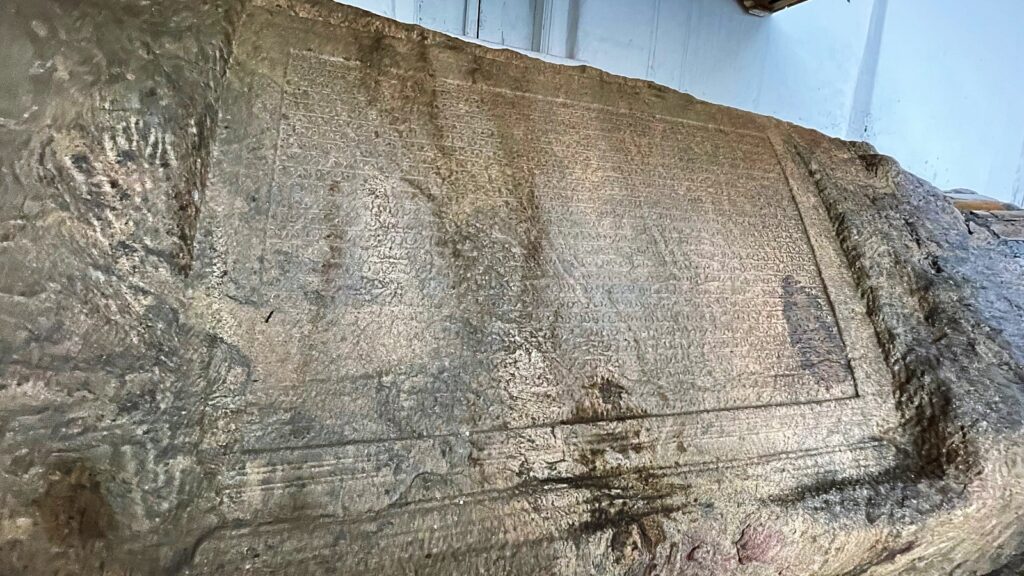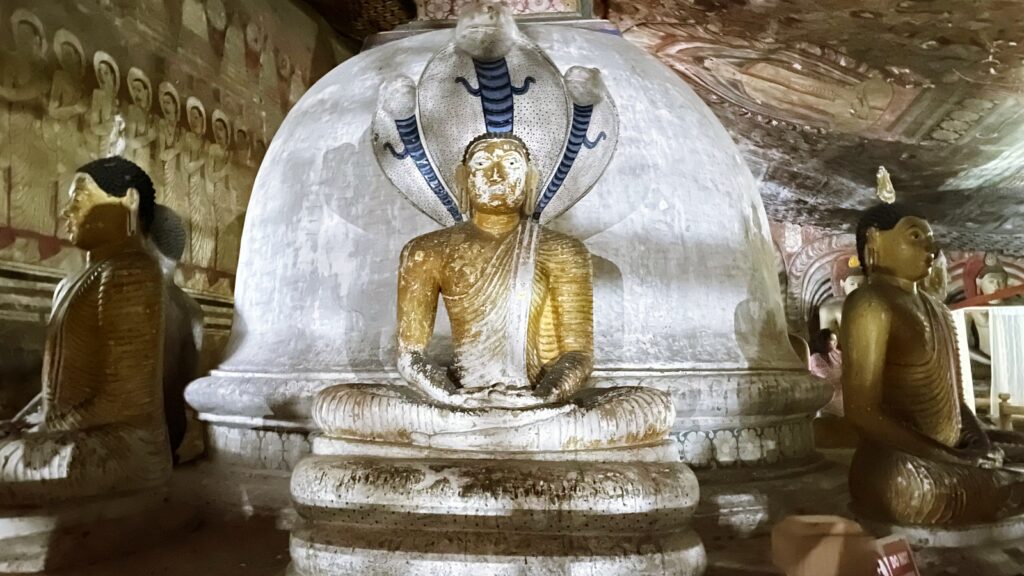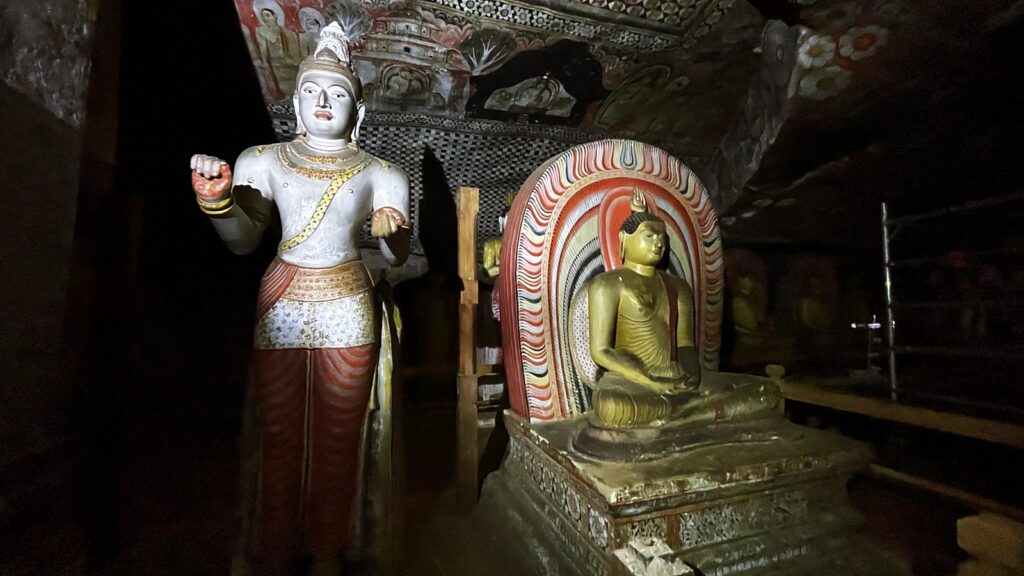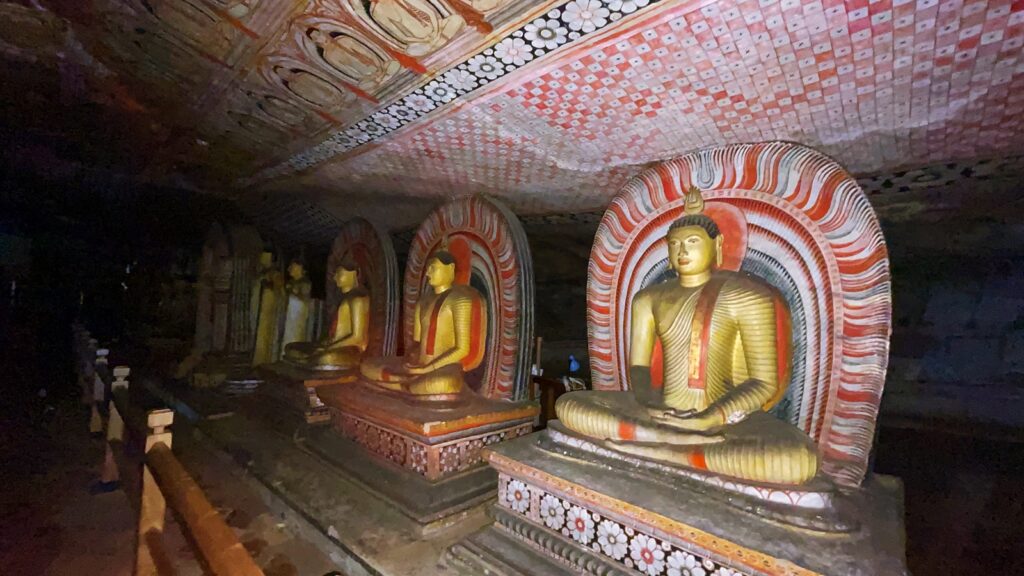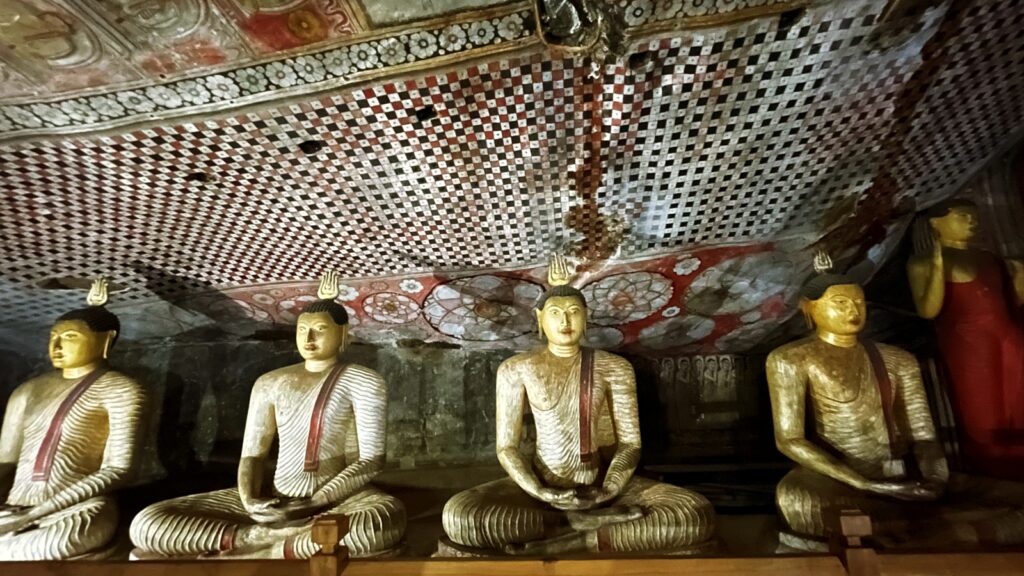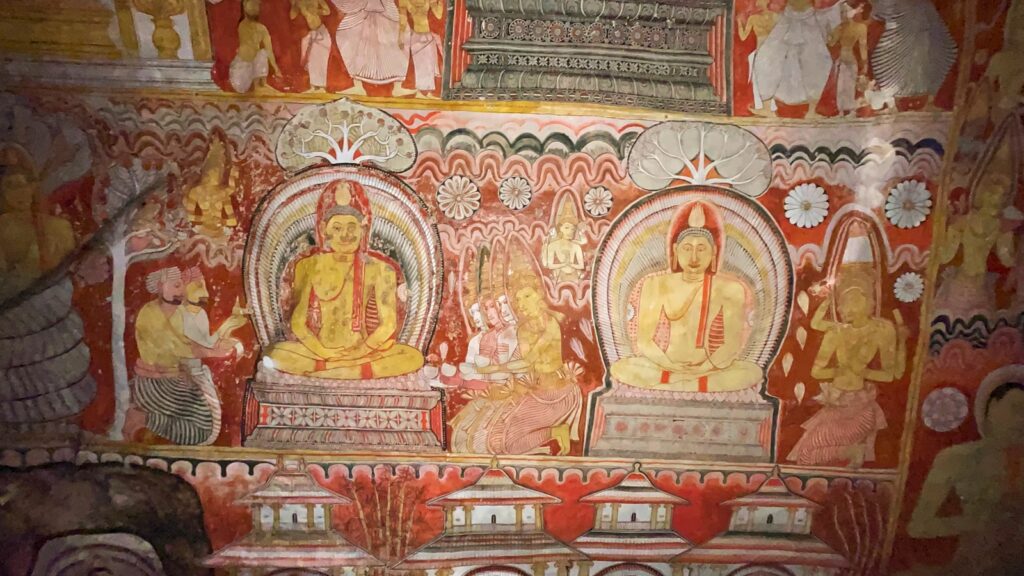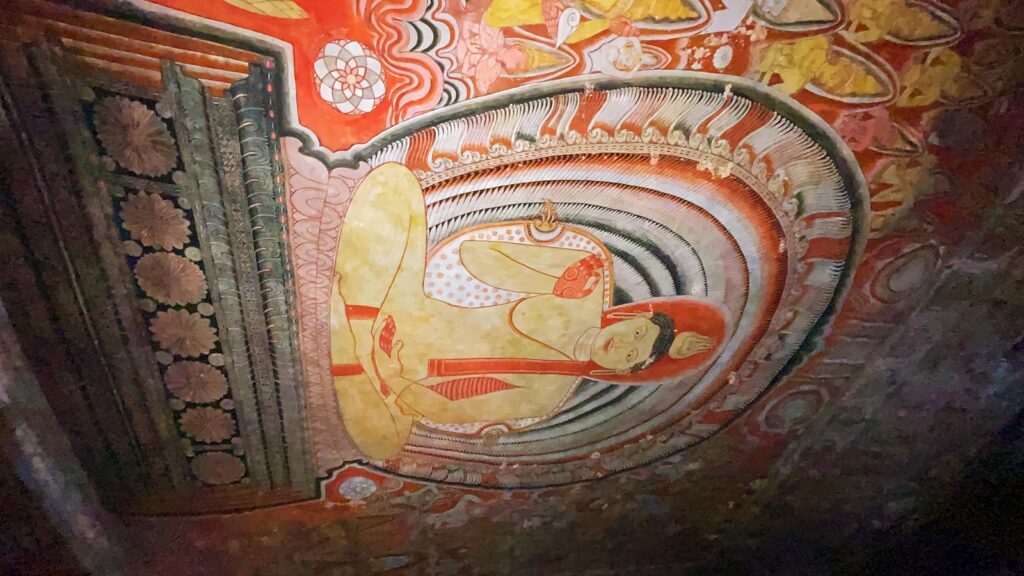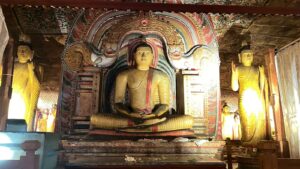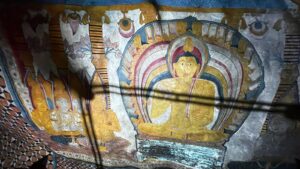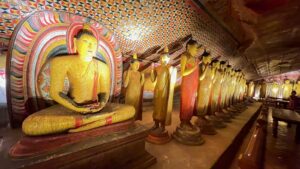Dambulla Golden Temple: Sri Lanka’s Best Preserved Cave Complex
In a small town in the north of Matale, where the landform is parallel with the ground, Dambulla Golden Temple, towering at 525 ft, stands out with its high mound golden Buddha. With roughly 15,000 monks, Sri Lanka houses almost 6,000 monasteries on its sacred grounds, but Dambulla royal temple is one of its best architectural masterpieces. This temple complex, beneath an enormous overhanging rock, was commissioned in the 1st century BC, and the scenes from its summit are among the best in Dambulla.

It was an overcast day with light showers but, that didn’t stop me from exploring one of the most magnificent sites of Dambulla. Primarily because this best-preserved cave temple complex in Sri Lanka has five of its ancient caves sculpted with a drip line that keeps the insides dry throughout the year. Boasting 153 Buddha statues, three statues of emperors, and four of Vishnu and Ganesha, this rare temple holds the ability to leave you spellbound even if you are not religious.

The murals blanket 23,000 sq ft of the temple complex including, wall impressions such as Buddha’s first sermon and the temptation by the demon Mara. On the inside, the cave ceilings are painted, with elaborate exemplars of religious icons (Buddha and others) matching the silhouettes of the rock. The arched columns and gabled porches, however, were added later in 1938.
Having said that, even though some of the most influential statues and paintings akin to Buddha’s life diverge across these five caves, 80 similar caves perch in the neighbourhood. Those I plan to explore on my next trip to Dambulla! But for now, let’s take a look at the Golden Rock Temple and its five ancient caves that will win your heart with their parietal art.
Table of Contents
Dambulla Golden Rock Temple Entrance

This world heritage site is up on top of a large rock with two opposed entrances. Both these entrances have car parking lots that trail to the temples but only one of these is where you can buy the entrance ticket. The entrance fee to the Dambulla Cave Temple is 1,500 LKR per person that they expect you to pay in cash, either LKR or USD. The ticket office closes at 5 pm, so I suggest you visit in the morning or late in the afternoon. Visiting during the daytime entitles you to phenomenal views that makes the entire experience wholesome.

I got to the temple at around 2.30 pm, and after 25-minutes of climbing 200 odd stairs, I finally arrived at the main temple door, where I was asked to take off my shoes. At this spot, you will meet a few hawkers trying to sell souvenirs such as fridge magnets. I bought a pack of 10 magnets for LKR 500. As for the dress code, you must wear something that has your knees and shoulders covered, and you also need to take off your hat before entering the temple.

Five Ancient Caves of Golden Rock Temple
While a small dagoba style gate establishes the entrance of Dambulla Golden Rock Temple, the inside of the cave complex is bound to surprise you with its massiveness. It’s almost hard to believe, as to how these caves must have been hand-carved, let alone the fact that it was occupied by numerous monks for several centuries. One can only imagine the effort it would have taken to model such extensive caves in solid rock!

It was a breathtaking sight, to say the least, as I crossed over the small gate to enter the vast premises built 525 feet above ground level. On the offset, the adjoining caves are all under the same rock signed by a cobblestone walkway. The most massive cave averages about 75 feet from the entrance to the rear, 170 feet from east to west, and is 22 feet tall at its highest point.
Cave of the Divine King
The first cave I popped in on was Devaraja Lena, also known as the Cave of the Divine King.

At the entrance of the first cave, you will see a 1st-century Brahmi inscription that narrates the record of the establishment of this monastery.

While on the inside, a 46 feet Buddha statue chiselled out of rock dominates the interiors. This statue, as told by my guide, has been repainted many times over the course of years and is said to have undergone its last in the 20th century. Age-old impressive paintings cover the walls and the ceilings of this ancient cave.

Literally, hundreds of age-old impressive paintings of Buddha cover the walls and the ceilings of this ancient cave, something that must’ve taken ages to develop! Walk beside the Buddha’s feet, and you will notice the mural of his favourite disciple, Ananda, and as the story goes, at his head, lord Vishnu used his divine powers to build the caves. It’s unlikely to not get impressed by the architecture, paintings or the history behind the temples.
Cave of the Great Kings
The second cave is the largest of all and is called Maharaja Lena, the Cave of the Great Kings. Here you descry 16 standing statues of Buddha, 40 seated statues of Buddha, garlanded divinities Saman and Vishnu, and statues of King Vattagamani Abhaya and King Nissanka Malla. On the left side of Maharaja Lena, you will find a rock-felled Buddha statue accompanied by wooden statues of the Avalokiteshvara Natha and Bodhisattvas Maitreya.
As inscribed on a stone near the monastery entrance, King Vattagamani Abhaya sanctified the monastery in the 1st-century BC, wherein King Nissanka Malla gilded 50 statues in the 12th century. This cave also has a dagoba and a spring with healing powers. Walking by this cave, I also noticed characteristic tempera paintings on the ceiling that dates back to the 18th century and paint Buddha’s life, from Mahamaya’s dream to demon Mara’s temptation.
Other illustrations depict significant events from Sri Lanka’s history. In between the first and the second cave, you will cross over a small Vishnu Devale that seemed to be drawing several devotees.
Maha Alut Vihara

Maha Alut Vihara is the third cave, and it’s also known as the Great New Monastery. This cave is a tryst with Kandayan styled ceiling and wall paintings, drawn and drafted in the 17th-century following the rule of King Kirti Sri Rajasinha, a renowned Buddhist evangelist.

Apart from the 50 Buddha statues, this cave also houses the statue of King Kirti Sri Rajasinha.
Paschima Viharaya

The 4th and the 5th caves are comparatively smaller than the rest and are said to date from a succeeding age. Paschima Viharaya, or the Cave of Western Temple, is the fourth in succession that portrays a peaceful Buddha in a meditative pose in addition to more Buddha portraits and statues.
Devana Alut Viharaya

Devana Alut Viharaya, or the Cave of Second New Temple, is the 5th, the last and the most recent cave of the temple complex. In this cave, you will get to see diverse paintings and statues of Buddha. While the statues and pictures at the other caves are carved, in granite rock, in this cave, they are built from brick and plaster.

Each of these ‘shrine rooms’ is emblematic of many periods of Sinhala art and sculpture. Even though you will come across many Buddha statues in varying sizes and attitudes, the largest being 50 feet long. It usually takes only an hour or two to explore all the caves. The Golden Buddha statue is downhill from the Cave complex. It rests in the wheel-turning pose or Dhamma Chakra Mudra over an eminent red-lipped dragon decorated with neon signs.
Dambulla Cave Timeline:
1st-century BC: Paintings and statues
2nd – 5th century BC: Stupas were built
3rd – 7th century BC: Early inhabitants
12th-century: Additional statues of Hindu gods were added
18th-century: Cave and shrine buildings were completed
19th-century: Additional caves and paintings were added
20th-century: lighting and UNESCO reconstruction was facilitated

